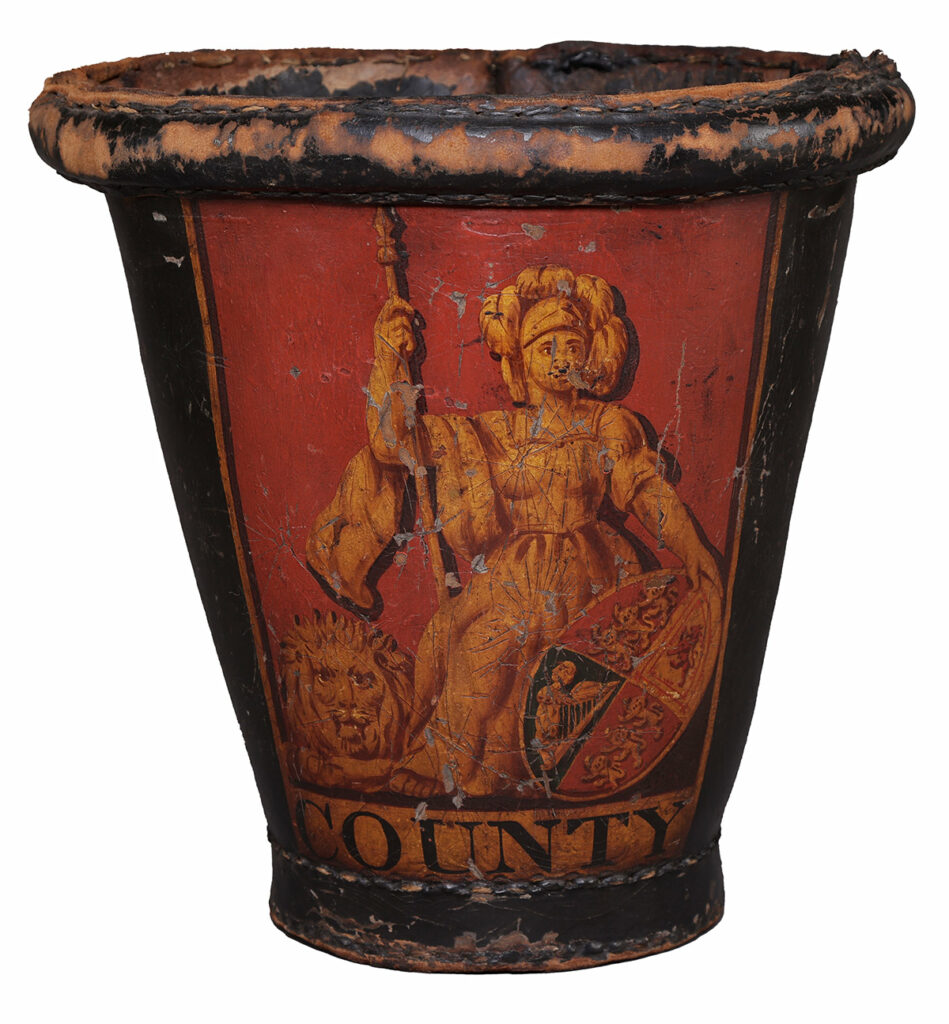Underlying the development of fire insurance and firefighting that we have covered in our online exhibition, Fire! Risk and Revelation, is the humble fire bucket. We have featured buckets many times in the galleries and produced a 3D Image that you can investigate from all angles on Sketchfab here.
The fire bucket was one of the main means of firefighting before the development of the fire engine. Along with fire hooks, ladders and squirts, the bucket was efficient for putting out small fires, before they developed into something uncontrollable. Firefighting equipment was traditionally kept in a church for use in a parish and it was a collective effort from the parishioners to put fires out.
Ladders enabled people to reach rooves or upper windows and fire hooks would bring down burning parts of rooves, often thatch, to stop it spreading. Buckets though, were the only means available for carrying water. Friends and neighbours would form a human chain passing buckets of water back and forth from the source of water to the fire. There was the problem of the availability of water. If a water source was too far away, water levels were low or the tide out in tidal areas, then fires could get out of control. Even when fire engines were developed, buckets were needed to fill the engine’s cistern, again by hand along a human chain.

Construction
During the 18th century fire buckets were in much demand by insurance companies for their firefighters. They were made by artisan leather workers. Soaked leather, cow hide, was stretched over a mould, hand sewn and then lined with pitch or tar. The top was turned over with slit cane or rope forming the rim, and an insert was placed at the bottom for strength. A leather handle completed the bucket. Later in the mid-19th century, riveting was introduced, replacing some of the stitching. Copper bands were used on the rim to strengthen the buckets, which also made them attractive objects. The rivets and banding further strengthened the buckets, as they had to be tough, durable and waterproof. Buckets had a rough treatment during fires.
Design
The Fire offices used branding on everything, from paperwork, through to their fire marks, buckets, and firefighting uniforms. It was far advanced compared to what other companies and professions were doing at the time.
Both regional and London fire offices used individual designs and branding to distinguish themselves from each other. Many fire insurance companies would attend a fire, and clarity was needed to establish who worked for which company. This was reflected in firefighter livery, the colours they wore, their badges, the equipment, such as fire engines and of course, fire buckets. There was a practical purpose for the branding of fire buckets. The scenes of fires could be chaotic and disordered, and when companies worked together, it would be clear which bucket belonged to who.
There was another reason, which was marketing, to ensure the maximum promotion for the fire offices and to attract new customers. Imagine seeing a horse-pulled fire engine flying past you on a street with a line of buckets down the side, all bearing the same logos.
Care was taken to produce these buckets with the company emblems on. They were beautifully hand painted in bright colours. The bucket we feature here is from the County Fire Office which was founded in 1807 by an “association of noblemen and gentlemen” for the particular benefit of residents in country districts, specialising in insuring country homes and farms.
The bucket is black, with the brightly coloured emblem, displaying Britannia armed with a spear and shield, and lion at her side, above the word “COUNTY”. Britannia’s shield bears the Royal Arms as they were in 1807, with an inescutcheon of the arms of Hanover.
In-situ fire buckets
Enjoy looking at our 3D image of the County Fire Office bucket, and watch out for them in other places, frequently in museums, but also historic houses. You can often find lines of fire buckets in-situ, hanging up high in the service areas. Firefighting equipment, including fire engines, was stored onsite for firefighting in what was often remote locations.
Play our game
Want to find out how difficult it is putting out a fire using traditional techniques? Play our ‘Douse the fire’ game on our online gallery here.
